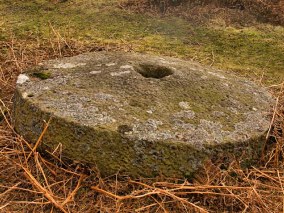Millstone images - more domes Home Millstone page
 |
A domed millstone on the NE side of Carl Wark - a classic Derbyshire "Grey" . Boulders were worked by individuals (or small groups) where they were found - this one, around 2 metres in diameter, will weigh over 2 tons and is on a steep slope. Dating domed stones is problematic, but it seems likely their use finished by the early 18th century at the latest. They can be found in a variety of states, from crude rough-outs through to ready to go, as here. The hole or more correctly, "eye" was sometimes chipped through right at the start, but sometimes millers specified that they would cut it on delivery, and moving a stone without an eye must have been very difficult.
|
 |
Domed stones are often marked with a VV or W (as in this case on Gardom's Edge) or X marks. The VV ( known as a conjoined V) mark is familiar to archaeologists who study symbols and graffiti in medieval buildings - it is an "apotropaic" marking intended to keep evil spirits at bay. "VV" probably refers to Virgo Virginum (Virgin of Virgins) and has been found in locations as varied as Wookey Hole (Somerset) and some door jambs & lintels at Hardwick Hall. An extensive collection have recently been found at Creswell Crags where they are thought to have been intended to contain spirits emerging from underground. Perhaps quarried stones were thought to have carried some unwelcome essence. Anyone moving a millstone must have been well aware of the danger that toes and fingers are easily squashed by such heavy objects. Marks of this kind had a long half life as good luck symbols on structural timbers until the 19th century, but were probably most widely carved when belief in witchcraft was at it's height in the early 17th century.
ref: Billingsley J. (Editor), et al. 2017
Hidden Charms 2017: A conference held at Norwich Castle April 2nd, 2016 Hebden Bridge, Northern Earth Books.
|
 |
"1622" is carved into a face on Froggat Edge, close to some abandoned domed millstones. Perhaps a terminal date for the quarry and a date for domed millstones? maybe....
|
 |
Gardoms Edge - this time the upper, domed side was completed first, then the boulder was turned over onto the chock and the working face finished - but at some stage several chords have broken off - accident or deliberate destruction?
|
 |
Gardoms Edge - an apparently perfect domed millstone - until a section broke off - or was broken off.
Speculation - as it is likely that Gardoms Edge would have been owned by the Duke of Devonshire, it is conceivable that this damage dates from Civil War times, when the local Parliamentary commander was Sir John Gell, a notably vindictive man who used the war to settle personal scores and was certainly capable of ordering the destruction of property of a Royalist such as the Duke.
|
 |
An old domed millstone on Gardoms Edge. Many domed millstones have a single section broken off (see above) and it is usually assumed these were accidents that occurred during manufacture, but this stone shows something more sinister. This stone was fully formed and then had at least 3 chords broken off - unlikely to be the work of the millstone maker, who would surely have given up after the first break.
|
 |
A domed millstone at the site of an old mill at Hulme End - a very rare sight; domes went out of use in the mid 18th century and this is the only example I know of a domed millstone at a mill (other than the beveled 19th century stone at Stainsby). Let me know if you have seen another:
|
 |
A rare intermediate on Curbar Edge - a combination of dome and square edge.Appears fully formed, complete with eye, but a singleton - no sign of a bed stone.
|
Copyright @ 2007 Stephen N.Wood. All rights reserved.